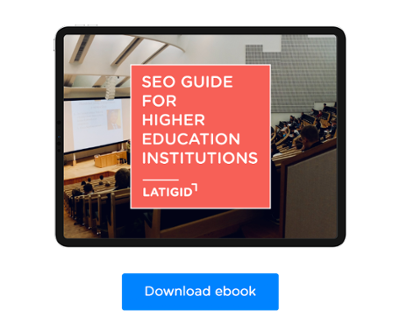
In this article we'll explore the unique aspects of SEO for higher education and provide actionable insights to help you make the most out of your program pages.
Importance of SEO for Higher Education Institutions
The importance of SEO for higher education institutions cannot be overstated in today's digital landscape. As universities and colleges strive to attract prospective students and engage with their communities, effective search engine optimization (SEO) strategies have become a cornerstone of success.
With the majority of students beginning their educational journey online, institutions must ensure their program pages are easily discoverable. SEO techniques improve search engine rankings, making it more likely for prospective students to find and explore relevant educational offerings. This increased visibility leads to higher click-through rates, attracting more organic traffic and expanding reach. As a result, the likelihood of converting visitors into applicants also grows.
SEO is not just an option for higher education institutions; it's a necessity. By optimizing program pages, institutions can effectively reach their target audience, provide valuable information, and create a strong online presence that resonates with prospective students.
Benefits of Optimizing Program Pages
Optimizing program pages for higher education institutions brings a wide array of benefits that directly contribute to their success in the digital age. Here are some of the key advantages of investing in the optimization of program pages:
Enhanced Visibility: Optimization improves the visibility of program pages in search engine results. When pages rank higher, they are more likely to be seen by prospective students who are actively searching for relevant educational offerings.
Increased Organic Traffic: Higher rankings lead to increased organic traffic. Optimized program pages attract more visitors without relying solely on paid advertising, making it a cost-effective strategy for driving traffic.
Improved User Experience (UX): Optimization often involves improving the overall user experience. This includes faster loading times, easy navigation, and valuable content, all of which contribute to a positive impression and longer on-page engagement.
Higher Conversion Rates: Well-optimized program pages are designed to guide visitors toward specific actions, such as filling out application forms or requesting more information. By creating clear calls to action and user-friendly forms, institutions can boost conversion rates.
Targeted Engagement: Optimization allows institutions to align program content with the queries potential students are searching for. This targeted approach ensures that the right audience is engaging with the information they're seeking.
Cost-Effectiveness: Compared to ongoing paid advertising, optimization is a more sustainable and budget-friendly way to generate consistent traffic and attract potential students.
Long-Term Results: Once optimized, program pages can continue to attract organic traffic over an extended period. This sustainable approach delivers ongoing benefits without the need for constant intervention.
Positive Brand Perception: A well-optimized program page reflects positively the institution's overall brand. When users find valuable and relevant information easily, it fosters a sense of trust and credibility.
Flexibility for Changes: Program offerings and educational content may change over time. Optimized pages are more adaptable to updates, ensuring that accurate and up-to-date information is readily available to visitors.
Alignment with Student Expectations: Today's students expect easy access to information online. Optimized program pages meet these expectations by providing a seamless digital experience.
Engagement Across Devices: With mobile usage on the rise, optimization ensures that program pages are responsive and accessible across various devices, catering to the preferences of modern users.
Related article: Increasing Student Enrollment: SEO Techniques for Universities
Key Elements of Optimizing Program Pages
Optimizing program pages involves a strategic approach that encompasses various key elements to ensure maximum effectiveness in attracting and engaging potential students. Here are the essential elements to consider when optimizing program pages for higher education institutions:
Keyword Research and Targeting
- Conduct thorough keyword research to identify relevant terms and phrases that potential students are searching for.
- Target keywords that accurately represent the program's offerings, benefits, and unique features.
- Prioritize long-tail keywords that have lower competition and higher intent.
On-Page Optimization
- Craft compelling and descriptive meta titles and meta descriptions that incorporate target keywords and encourage clicks from search results.
- Optimize header tags (H1, H2, H3, etc.) to structure content and indicate hierarchy.
- Use keywords naturally within the content, avoiding keyword stuffing.
High-Quality Content
- Create informative and engaging content that addresses the needs and questions of prospective students.
- Showcase program details, curriculum highlights, faculty expertise, admission requirements, and potential career outcomes.
- Utilize clear and concise language, avoiding jargon that might confuse visitors.
Engaging Visuals
- Incorporate relevant images, infographics, and videos to enhance the visual appeal and informational value of the page.
- Optimize images for fast loading times and include descriptive alt text for accessibility and SEO.
Clear Calls to Action (CTAs)
- Include prominent and actionable CTAs that guide visitors toward desired actions, such as applying, requesting information, or scheduling a campus tour.
- Use contrasting colors and persuasive language to encourage click-throughs.
Internal Linking
- Implement internal links to connect program pages to relevant content within the institution's website.
- Improve navigation by providing pathways for users to explore related programs, admission details, and campus life.
Mobile Responsiveness
- Ensure program pages are fully responsive and accessible across various devices, including smartphones and tablets.
- Test mobile usability and optimize page elements for smaller screens.
Page Speed Optimization
- Optimize images, minimize code, and leverage browser caching to improve page loading speed.
- Faster loading times enhance user experience and contribute to better search engine rankings.
Structured Data Markup
- Implement structured data markup (Schema.org) to provide search engines with additional context about the program, such as course details, faculty information, and reviews.
- Rich snippets in search results can improve click-through rates.
Social Proof and Testimonials
- Incorporate student testimonials, success stories, and alumni achievements to build credibility and trust.
- Positive reviews and experiences from current and past students can influence decision-making.
Local Optimization
- If applicable, optimize program pages for local searches by including location-specific information, such as campus addresses and maps.
- Claim and maintain Google My Business profiles for each campus or location.
Continuous Monitoring and Optimization
- Regularly review analytics data to assess page performance, user behavior, and conversion rates.
- Adjust optimization strategies based on insights to improve results over time.
In conclusion, optimizing program pages requires a holistic approach that combines keyword research, on-page optimization, high-quality content, engaging visuals, effective CTAs, and technical considerations. By addressing these key elements, institutions can create program pages that rank well in search results, provide valuable information to prospective students, and drive desired actions.
Related article: SEO for Universities: Keyword Research Guide
About LATIGID
We are a Higher Education Marketing Agency, specializing in SEO. We help you grow by increasing website traffic, generating more student leads, and closing those leads into enrollment. With a deep understanding of the latest industry trends and best practices, we are well equipped to help your institution grow.
If you are looking for a Higher Education Marketing Agency to partner with, check our page to see what we can do for you!
Download our SEO guide and learn how to build a strategy to optimize your Higher Education Institution's website




